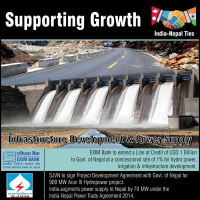India and Nepal Cooperate in Energy Ahead of SAARC Summit
 The 900MW Arun III hydropower station is expected to begin producing electricity in 2020.
The 900MW Arun III hydropower station is expected to begin producing electricity in 2020.
India and Nepal have made a significant breakthrough in energy cooperation. Our neighbour has given an Indian company permission to build a 900 megawatt hydropower plant, government officials said on Monday, in a win-win for both sides. The Himalayan state is set to ease its chronic energy shortages by opening up its rivers to Indian companies – this will provide Nepal with free electricity and India with energy for our power-hungry economy,
The two countries signed an agreement for the $1.04 billion project on Tuesday as South Asian heads of state began arriving for the regional SAARC summit in Kathmandu.
Indian firms are investing billions to develop Nepal's hydropower potential, encouraged by an electricity trading pact signed between the two countries last month and pushed by Prime Minister Narendra Modi. Kathmandu estimates $7 billion will be invested in its hydropower industry over the next 5 years.
Growing investment in Nepal's energy industry comes as New Delhi looks to grow its influence in its smaller neighbours, where China is increasingly active.
The project, which will be built by Satluj Jal Vidyut Nigam (SJVN) Limited, was originally cleared in 2008 but never implemented after Kathmandu lobbied for greater benefits.
Under the agreement SJVN will develop the plant on the Arun River in the country's east, and supply a fifth of generated electricity to Nepal for free, said Ghanashyam Ojha, external affairs chief at the Investment Board Nepal.
Nepal will earn $3.48 billion over 25 years in royalty, income and taxes from the plant, officials said, and will then take ownership of the project.
Indian firms are negotiating with the government for power plants that would produce a total of 8,250 MW, officials in Nepal said. Our neighbour has the potential to generate 42,000 MW of hydropower but today produces a mere 800 MW – less than the demand of 1,400 MW.
To Learn More:
Nepal Signs Indian Power Deal During Modi Visit (by Binaj Gurubacharya, AP)
Nepal gives Indian firm green light for $1 billion hydroelectric plant (by Gopal Sharma, Reuters)
- Top Stories
- Controversies
- Where is the Money Going?
- India and the World
- Appointments and Resignations
- Unusual News
- Latest News
- India College Chain’s Expansion into U.S. Draws Opposition from Massachusetts Officials over Quality of Education
- Milk Shortages in India Tied to Release of New Movies Featuring Nation’s Favorite Stars
- Confusion Swirls around Kashmir Newspaper Ban in Wake of Violent Street Protests
- Polio-Free for 5 Years, India Launches Vaccine Drive after Polio Strain Discovery
- New Aviation Policy Could Increase Service, Lower Ticket Prices






Comments